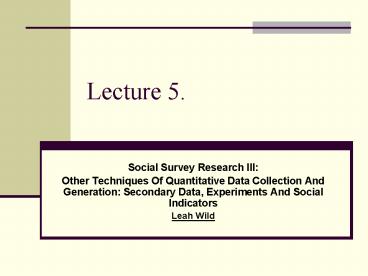Social Survey Research III: - PowerPoint PPT Presentation
1 / 15
Title:
Social Survey Research III:
Description:
Using Existing Sets of Questions & Secondary Data Sets. Data Collection and Experimental Design ... Between 1982- 2001 biennial. From 2001 annual. ... – PowerPoint PPT presentation
Number of Views:706
Avg rating:3.0/5.0
Title: Social Survey Research III:
1
Lecture 5.
- Social Survey Research III
- Other Techniques Of Quantitative Data Collection
And Generation Secondary Data, Experiments And
Social Indicators - Leah Wild
2
Overview
- Questionnaire Design Response Format
- Pilot Questionnaires
- Using Existing Sets of Questions Secondary Data
Sets - Data Collection and Experimental Design
- Social Indicators
- Society at a Glance OECD Social Indicators 2002
Study - BCS
3
Questionnaire Design Response Format Intensity
scales. A good way of writing closed-ended
questionnaire items is to measure peoples
attitudes and opinions with intensity scales. A
commonly used one is the Likert scale, a scaling
technique designed by Rensis Likert in 1932. It
typically makes use of a 1 to 5 rating scale
where 1 is strongly agree, 2 is somewhat
agree, 3 is neutral, 4 is somewhat
disagree and 5 is strongly disagree
4
Pilot Questionnaires And Interview Schedules
- Clarity Check
- Adequacy of Instructions Check
- Gain Experience In Asking Questions (i.e.
Interview Schedules)
5
Secondary Data.
- secondary data as any information that has not
been generated personally (first-hand) by the
researcher who uses it. - highly quantified sources -statistics
- to the more qualitative -personal documents and
diaries, government and business reports and the
mass media. - can be contemporary or historical.
- saving of time, money and effort.
- use of secondary sources may be a necessity if
historical and / or comparative research is being
carried-out.
6
Problems with Secondary Data
- Authenticity
- Credibility
- Representativeness
- Meaning (literal and metaphorical)
- Purpose
- (Scott 1990. Documents in Social Research
Social Studies Review, 1990)
7
Reasons to Use Secondary Data.
- Availability.
- Examination of trends / changes over time.
- Comparisons.
- Before" and "after" studies.
- (Bilton et al 1997)
8
USING META-DATA.
- Traditionally
- metadata has been understood as Data about Data
- an integral part of the dataset. - Metadata can include such items as
- Questionnaires
- a keyword list of names and items
- a record of how the data were collected
- an inventory of related data and publications
- information on principal investigators
- geographical coverage.
- Metadata is important as it provides essential
information on the use and interpretation of
information contained in a data file. It outlines
what datasets are available, where they can be
found, what format they are in, how they should
be used, and can provide a permanent record in
catalogues and search facilities of the resources
that are available.
9
Data Collection Secondary Data Sets
- British Household Panel Survey (longitudinal)
- 5,500 Households,
- 10,000 Individual interviewees
- 75 response rate
- Focus is on social and economic change at
individual and household level - Topics include
- Income
- Employment
- Housing
- health
- Attitudes.
10
Labour Force Survey
- 1973 Onwards
- Up to 60,000 households
- 80 response rate
- Topics include
- Employment
- Education and Training,
- Health and Disabilities
11
General Household Survey
- Annual since 1971 (except 97-98 and 99-00)
- 10,000 households, 25,000 people
- 72 response rate
- Topics include
- household and family information
- housing tenure and household accommodation
- consumer durables including vehicle ownership
- employment
- education
- health and use of health services
- smoking and drinking
- family information including marriage,
cohabitation and fertility - income
- demographic information about household members
including migration.
12
British Crime survey
- a 'victimisation' survey,
- experiences of property crimes and personal
crimes - provides a record of the experience of crime
- unaffected by variations in the behaviour of
victims about reporting - Unaffected by variations in police
procedure/practice - Between 1982- 2001 biennial. From 2001 annual.
- Target population All households in England and
Wales - Sampling unit People aged 16 or over living in
private household. - Design/selection of sample Stratified random
sample of postcode sectors. One quarter sector
selected at random. Interviews conducted at
address - Size20,000 respondents in BCS (2000) core
sample, plus 4,000 ethnic minority booster
sample. - Enlarged sample size in 2001. 40,000 core sample
- Core crime counting questions remain unchanged
since first sweep (1982). Other questions asked
on ad hoc basis. Moved to CAPI /CASI 1994.
13
Data Collection and Experimental Design
- When interested in understanding how the
manipulation of a variable can explain specific
outcomes on another variable, experiments can
also be used. - Experimental Group
- Some treatment is conducted on the subjects of
the experimental group and measures its effects
in comparison to another group. - Control Group
- Control group might not receive any treatment or
it might receive a different kind of treatment
14
Social Indicators
- Society At A Glance OECD Social Indicators 2002
Study - Context Indicators illustrate national
differences in social trends and social status - Response Indicators. Four areas of social policy
have been operationalised - Self-sufficiency
- Equity
- Health
- Social Cohesion
15
- UK official statistics www.statistics.gov.uk
- UN statistics www.un.org/depts/unsd/global.htm
- OECD statistics www.oecd.org/statistics
- EU statistics europa.eu.int/comm/eurostat/































